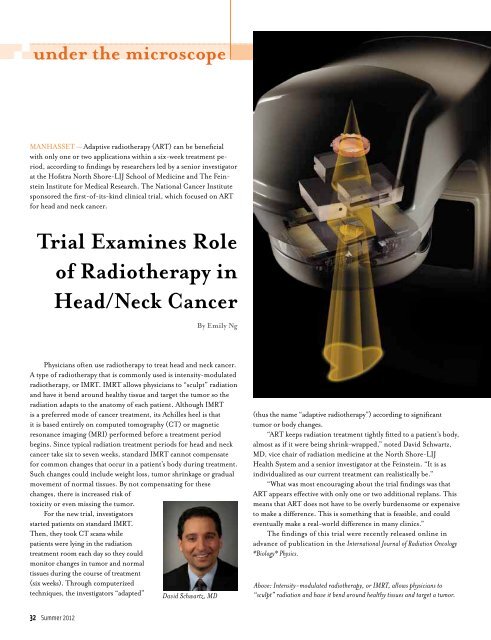Support for Soldiers and Veterans You Gotta Have Heart The Joy of ...
Support for Soldiers and Veterans You Gotta Have Heart The Joy of ...
Support for Soldiers and Veterans You Gotta Have Heart The Joy of ...
Create successful ePaper yourself
Turn your PDF publications into a flip-book with our unique Google optimized e-Paper software.
under the microscope<br />
MANHASSET — Adaptive radiotherapy (ART) can be beneficial<br />
with only one or two applications within a six-week treatment period,<br />
according to findings by researchers led by a senior investigator<br />
at the H<strong>of</strong>stra North Shore-LIJ School <strong>of</strong> Medicine <strong>and</strong> <strong>The</strong> Feinstein<br />
Institute <strong>for</strong> Medical Research. <strong>The</strong> National Cancer Institute<br />
sponsored the first-<strong>of</strong>-its-kind clinical trial, which focused on ART<br />
<strong>for</strong> head <strong>and</strong> neck cancer.<br />
Trial Examines Role<br />
<strong>of</strong> Radiotherapy in<br />
Head/Neck Cancer<br />
Physicians <strong>of</strong>ten use radiotherapy to treat head <strong>and</strong> neck cancer.<br />
A type <strong>of</strong> radiotherapy that is commonly used is intensity-modulated<br />
radiotherapy, or IMRT. IMRT allows physicians to “sculpt” radiation<br />
<strong>and</strong> have it bend around healthy tissue <strong>and</strong> target the tumor so the<br />
radiation adapts to the anatomy <strong>of</strong> each patient. Although IMRT<br />
is a preferred mode <strong>of</strong> cancer treatment, its Achilles heel is that<br />
it is based entirely on computed tomography (CT) or magnetic<br />
resonance imaging (MRI) per<strong>for</strong>med be<strong>for</strong>e a treatment period<br />
begins. Since typical radiation treatment periods <strong>for</strong> head <strong>and</strong> neck<br />
cancer take six to seven weeks, st<strong>and</strong>ard IMRT cannot compensate<br />
<strong>for</strong> common changes that occur in a patient’s body during treatment.<br />
Such changes could include weight loss, tumor shrinkage or gradual<br />
movement <strong>of</strong> normal tissues. By not compensating <strong>for</strong> these<br />
changes, there is increased risk <strong>of</strong><br />
toxicity or even missing the tumor.<br />
For the new trial, investigators<br />
started patients on st<strong>and</strong>ard IMRT.<br />
<strong>The</strong>n, they took CT scans while<br />
patients were lying in the radiation<br />
treatment room each day so they could<br />
monitor changes in tumor <strong>and</strong> normal<br />
tissues during the course <strong>of</strong> treatment<br />
(six weeks). Through computerized<br />
techniques, the investigators “adapted” David Schwartz, MD<br />
32 Summer 2012<br />
By Emily Ng<br />
(thus the name “adaptive radiotherapy”) according to significant<br />
tumor or body changes.<br />
“ART keeps radiation treatment tightly fitted to a patient’s body,<br />
almost as if it were being shrink-wrapped,” noted David Schwartz,<br />
MD, vice chair <strong>of</strong> radiation medicine at the North Shore-LIJ<br />
Health System <strong>and</strong> a senior investigator at the Feinstein. “It is as<br />
individualized as our current treatment can realistically be.”<br />
“What was most encouraging about the trial findings was that<br />
ART appears effective with only one or two additional replans. This<br />
means that ART does not have to be overly burdensome or expensive<br />
to make a difference. This is something that is feasible, <strong>and</strong> could<br />
eventually make a real-world difference in many clinics.”<br />
<strong>The</strong> findings <strong>of</strong> this trial were recently released online in<br />
advance <strong>of</strong> publication in the International Journal <strong>of</strong> Radiation Oncology<br />
*Biology* Physics.<br />
Above: Intensity-modulated radiotherapy, or IMRT, allows physicians to<br />
“sculpt” radiation <strong>and</strong> have it bend around healthy tissues <strong>and</strong> target a tumor.




